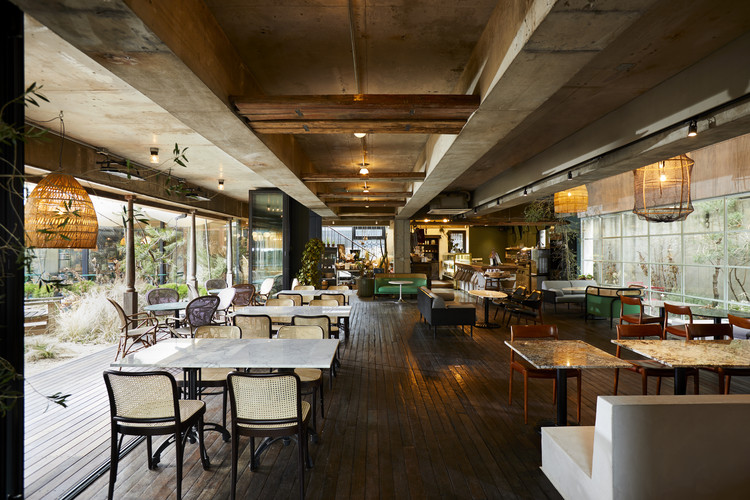Pine Gallery Taku Sakaushi (O.F.D.A.)
2014-10-15 01:00
© Hiroshi Ueda
(C)上田浩史(Hiroshi Ueda)


α空间插入
α Space Insertion
该项目的启动是为了继承Re-TEM公司最初建设的记忆,并改善周围环境。面向规划道路的最初办公室必须向后移动。关于在考虑建筑结构的情况下将建筑物拖回建筑物的可能性的讨论得出的结论是,如果拖曳,建筑物就会倒塌。客户同意我们的建议,以抽象的方式继承他的家庭记忆中的颜色和形状,而不考虑原来的建筑。他的办公室,雕刻神殿和小神社,以及他出生地入口的轮廓,都将被纳入整个计划。
This project was launched to inherit the memory of the initial building of Re-Tem Corporation and improve the surrounding environment. The initial office facing towards a planned road must be moved backward. The discussion on the possibility of dragging back the building with the constructor in consideration of the structure concluded that the building would collapse if dragged. The client agreed with our proposal for inheriting the colors and shapes in the memory of his family in an abstract manner without regard to the original building. The office, carving of deity and small shrine as well as the outline of the entrance of his birthplace were to be integrated into the overall plan.
© Hiroshi Ueda
(C)上田浩史(Hiroshi Ueda)


作为公司历史档案的办公室往往是封闭的,比如仓库。然而,我们建议增加一些额外的空间,以考虑将来可能使用该网站作为企业高管的一个交汇点,或供客户的父母在当地进行交流。我只是坚持认为,空间应该包含一些开放的东西,其目的与建筑的主要意图不同。以下是我提出这一想法的三个原因。
The office to serve as an archive of corporate history tends to be something closed like a warehouse. However, we proposed the addition of some extra space in consideration of the future possible use of the site as a meeting point of corporate executives or for local communication by the client’s parents. I simply insist that the space should embrace something a little open with a purpose different from the main intention of the building. I will describe the three reasons below that have led me to this idea.
© Hiroshi Ueda
(C)上田浩史(Hiroshi Ueda)


建筑物是一个框架
A building is a frame
第一个原因与我的“架构就是框架”的想法有关。曾经是我老师的一位建筑师说过:“一个人会‘习惯’一座建筑”。听到这句话,我感到有些失望,因为“习惯”了一座建筑,这也意味着人们可能会失去建筑物的新鲜感。从那以后,我一直在想那幢“没人习惯”的建筑,这个概念在原则上很难理解。建筑物是固定的,不会改变。然而,周围的环境,邻居和汽车,你看到从一个建筑物,或人,家具或宠物,如果你把你的眼睛变成一个房间是不固定的。这些情况将继续改变。撇开建筑物的固定属性不谈,我想创造一座对你来说永远都是新的建筑。为此,我得出的结论是,建筑物只能是这些不断变化的物体的框架。
The first reason is associated with my idea “Architecture is frame”. An architect who was my teacher once said “A man will get ‘accustomed to’ a building”. I felt somewhat disappointed hearing that as getting “accustomed to” a building could also mean that one might lose the sense of freshness in the building. Since then, I have been thinking of the building that “no one gets accustomed to”, the concept difficult in principle. Buildings are fixed and do not change. However, the surrounding environment, neighbors and cars you see from a building, or people, furniture or pets if you turn your eyes into a room are not fixed. These will remain changing. Leaving aside the fixed property of buildings, I wanted to create a building that would always be new to you. To this end, I reached the conclusion that a building can only be a frame of these changing objects.
© Hiroshi Ueda
(C)上田浩史(Hiroshi Ueda)


向城市开放的建筑物
A building open to a city
第二个原因与我在长野新树大学工作的经历有关。在那些日子里,我正在解决长野市中心街道上关闭商店的问题。这些显然是地方城市特有的问题也可能发生在城市核心地区。一旦有蔬菜杂货商、鱼市或酒吧的场地被清理出来建造公寓或办公室,地面就会马上被毁。要实现一个生机勃勃的城市,就必须通过一座向城市开放的建筑来从根本上振兴地面。当地的问题可能是由大型零售店、机动化或其他仅靠建筑无法解决的因素造成的。但是,一定要用建筑来改进,那就是在地面上创造一个不断发展成城市的人群。
The second reason is related to my experience when working for Shinshu University in Nagano. In those days, I was addressing the problems of streets with closed-down shops in the Nagano city center. These problems apparently specific to local cities could also occur in urban cores. Once the sites with greengrocers, fish markets or bars are cleaned out to construct apartments or offices, the ground level will be ruined in a moment. To achieve a lively city, the ground level must essentially be revitalized by a building open to a city. The local problems might be caused by large retail stores, motorization or other factors that cannot be solved by architecture alone. However, something must definitely be improved with architecture, that is, to create a continuous crowd in the ground level developed as a city.
© Hiroshi Ueda
(C)上田浩史(Hiroshi Ueda)


一幢大楼接纳我们
A building accepts us
三是与地震灾害有关。当大东日本地震发生时,我很难到达当地一座城市的一家旅馆,在那里我被电视上的图像所震撼。在东京,一些无法回家的人开始发现自己在地震后不知去向。一些像堡垒一样阻碍人们进入的公共设施被指控。我确信一座大楼不会是要塞。我认为建筑物应该像海绵一样灵活,可以吸收人们。
The third is related to an earthquake disaster. When the Great East Japan Earthquake occurred, I struggled to arrive at a hotel in a local city where I felt devastated by the images on TV. In Tokyo, a number of people unable to return home started to find themselves unknown where to go after the earthquake. Some public facilities that blocked the entry of people like a fortress were accused. I felt sure a building would be no fortress. I thought a building should be as flexible as a sponge that absorbs people.
© Hiroshi Ueda
(C)上田浩史(Hiroshi Ueda)


Residual space
公司(A)的历史档案(A)遵循上述建筑大纲,其结构为每303个音高有两个音高,作为现代的、抽象的建筑,以表达抽象的概念。相反,我决定为上面的三个季节创建的α空间(B)被设计成面向花园和长廊的广泛开放空间,以使各种类型的通信成为可能。该空间的结构是开放的狂热,这样客户将能够看到他的难忘的松树。将开放的α空间(B)插入到闭空间(A)中,利用剩余空间作为存储空间。此外,在这个α空间(B)中扩展了一个类似烟囱的空间,使阳光不仅在α空间(B)中,而且在封闭空间(A)中同时进行。经磷酸盐处理的钢板被用来覆盖α空间(B),作为一种材料来讲述客户公司作为钢铁回收企业的历史。
The historical archive of the company (A) that follows the building outline as abovementioned is structured with twobys every 303 pitch as a modern, abstract equivalent of the existing building to express the notion of abstractness. In contrast, the α space (B) I decided to create for the threereasons above is designed to be widely open space facing towards the garden and promenade to enable various types of communications. The space is structured to be open fanwise so the client will be able to view his memorable pine tree. The open α space (B) has been inserted into the closed space (A), and the residual space is used to make the storage space. Also, a chimney-like space is extended in this α space (B) to let the sunshine not only in the α space (B) but the closed space (A) at the same time. The phosphate-treated steel plates are used to cover the α space (B) as a material that tells the history of the client company initiated as a steel recycler.


花园和长廊
Garden and promenade
花园不仅是α空间(B)的花园,也是客户父母的长廊。人行道是由混凝土面板组成的,而其他部分则用铺路或花园中的石头和从客户出生地取来的石榴石组成。在分隔相邻房屋的部分混凝土墙上,以混凝土复制了客户出生地入口的轮廓,旧办公室的浮雕被仔细保存并放置在墙上。神像的雕刻已经与α空间的扇形同步,用混凝土实现了现代化。如果这家刚刚在现代世界重生的百年老公司能在未来创造一种新的企业沟通模式,那就太好了。
The garden serves not only as that for the α space (B) but as the promenade for the client’s parents. The footpath is made of concrete panels while the other sections are arranged with paving or garden stones found there as well as the gargoyles taken from the client’s birthplace. On part of the concrete wall partitioning the neighboring premises, the outline of the entrance of the client’s birthplace has been reproduced with concrete and the relief of the old office has carefully been preserved and placed on the wall. The carving of deity has been modernized with concrete in synchronization with the fan-like shape of the α space. It would be wonderful if the century-old company just reborn in the modern world can create a new mode of corporate communications here in the future.
© Hiroshi Ueda
(C)上田浩史(Hiroshi Ueda)
































































Architects Taku Sakaushi (O.F.D.A.)
Location Mito, Ibaraki, Japan
Category Extension
Architects in Charge Taku Sakaushi, Hirotoshi Takeuchi
Area 103.0 sqm
Project Year 2013
Photographs Hiroshi Ueda
























